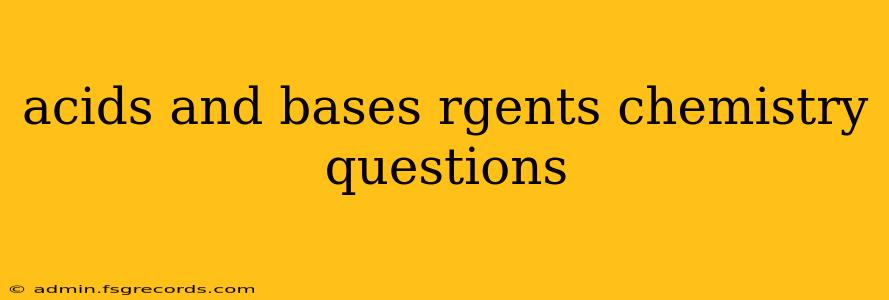This guide dives deep into the world of acids and bases, addressing common Regents Chemistry exam questions and providing comprehensive, insightful answers. Understanding acids and bases is crucial for success in chemistry, and this resource aims to solidify your knowledge and build confidence. We'll cover key concepts, definitions, and problem-solving strategies.
What are Acids and Bases?
Before tackling Regents-level questions, let's establish a strong foundation. Acids and bases are two fundamental classes of chemical compounds with distinct properties. Several definitions exist, but the most common are:
-
Arrhenius Definition: Acids are substances that produce hydrogen ions (H⁺) in aqueous solution, while bases produce hydroxide ions (OH⁻) in aqueous solution. This definition is simple but limited.
-
Brønsted-Lowry Definition: Acids are proton (H⁺) donors, and bases are proton acceptors. This definition is broader than Arrhenius, encompassing reactions without water.
-
Lewis Definition: Acids are electron-pair acceptors, and bases are electron-pair donors. This is the most general definition, encompassing reactions that don't necessarily involve protons.
For Regents Chemistry, the Brønsted-Lowry definition is usually sufficient. Understanding the different definitions is essential to solve a variety of problems.
Key Properties of Acids and Bases
| Property | Acids | Bases |
|---|---|---|
| Taste | Sour | Bitter |
| Touch | Can be corrosive | Can be slippery or soapy |
| pH | Less than 7 | Greater than 7 |
| Litmus Paper | Turns blue litmus paper red | Turns red litmus paper blue |
| Reaction with Metals | React with active metals (e.g., Zn) to produce hydrogen gas | Generally do not react with metals |
Common Regents Chemistry Questions on Acids and Bases
Here are some typical questions you'll encounter, along with explanations:
1. Identifying Acids and Bases
Question: Identify the acid and base in the following reaction: HCl + NaOH → NaCl + H₂O
Answer: In this neutralization reaction, HCl (hydrochloric acid) is the acid (proton donor), and NaOH (sodium hydroxide) is the base (proton acceptor).
2. Calculating pH and pOH
Question: A solution has a hydroxide ion concentration [OH⁻] = 1 x 10⁻¹⁰ M. Calculate the pH of the solution.
Answer: First, calculate the pOH using the formula: pOH = -log[OH⁻] = -log(1 x 10⁻¹⁰) = 10. Then, use the relationship pH + pOH = 14 to find the pH: pH = 14 - pOH = 14 - 10 = 4. The solution is acidic.
3. Understanding Acid-Base Titrations
Question: Explain the process of an acid-base titration and its purpose.
Answer: Acid-base titration is a laboratory technique used to determine the concentration of an unknown acid or base solution by reacting it with a solution of known concentration (the standard solution). A pH indicator signals the endpoint, which is the point at which the acid and base have completely neutralized each other. The purpose is to find the unknown concentration precisely.
4. Strong vs. Weak Acids and Bases
Question: What is the difference between a strong acid and a weak acid? Give examples.
Answer: A strong acid completely dissociates into ions in water (e.g., HCl, HNO₃, H₂SO₄). A weak acid only partially dissociates (e.g., CH₃COOH, H₂CO₃). The same principle applies to strong and weak bases. Strong bases completely dissociate (e.g., NaOH, KOH), while weak bases partially dissociate (e.g., NH₃).
5. Buffers and pH Changes
Question: What is a buffer solution, and how does it resist changes in pH?
Answer: A buffer solution is a solution that resists changes in pH upon the addition of small amounts of acid or base. It typically consists of a weak acid and its conjugate base (or a weak base and its conjugate acid). When acid is added, the conjugate base neutralizes it; when base is added, the weak acid neutralizes it, minimizing pH fluctuations.
Preparing for the Regents Chemistry Exam
This guide provides a solid foundation for understanding acids and bases. To succeed on the Regents exam, practice solving various types of problems, review key concepts thoroughly, and consult your textbook and class notes. Remember to understand the underlying principles, not just memorizing formulas. Consistent practice and a clear understanding of the core concepts will lead to success.

